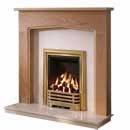Wood veneers or “real” wood veneers are creating a resurgence in the fireplace mantle industry with many manufacturers keen to move toward a more economical and ecological real wood alternative.
When an object is veneered a thin covering is applied to the surface to cover the true appearance of the object, mainly to make the veneered object more aesthetically pleasing. This process has mostly been used in woodwork, but now commonly used in masonry, stonework and dentistry, and lends itself perfectly to the fireplace surrounds industry. Pictured here is the Europa Beaufort in a natural oak real wood veneer finish.
the Europa Beaufort in a natural oak real wood veneer finish.
Fire surrounds or mantles are now using an array or desirable woods in the veneering process, creating appealing lightweight surrounds from renewable sources. Generally a wood veneer is no more than three millimeters in thickness and is obtained by peeling or slicing a tree trunk to the desired thickness. A process widely believed to derive from the Egyptians as they veneered many items, usually furniture.
The veneer process has been used widely within the fireplace sector and some manufacturers have now moved on from wooden veneers whereby the veneer is fixed usually with glue to a less alluring wood, i.e. particle board or medium density board, and use a stone or  marble effect material known as micro-marble as the veneer, and in some cases veneer onto metal apposed to the more common place MDF. Shown is the Europa Lancaster surround in the veneered off white stone effect.
marble effect material known as micro-marble as the veneer, and in some cases veneer onto metal apposed to the more common place MDF. Shown is the Europa Lancaster surround in the veneered off white stone effect.
Unfortunately veneer is often seen as tacky, cheep, and undesirable from previous generations of manufacturing, but be assured, veneering is now a well honed process, often appearing exactly the same as more expensive solid wood surrounds and thus will be around for generations to come.